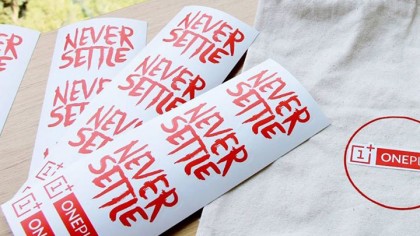OnePlus CEO: 'We didn't set out to create a low-cost phone'
How to make a supercheap superphone
You might wonder how a brand can survive for two years without looking to turn a profit, especially in the impossibly congested smartphone market. The answer lies fairly close to home, as OnePlus shares an investor with Lau's former employer, Oppo.

While Oppo Mobile and OnePlus are separate companies (despite the investor being named Oppo Electronic), Lau's new firm uses Oppo to manufacture its phones in the same way as Apple uses Foxconn, which helps a start-up gain access to the lower cost systems and components.
Another factor in the popularity of the One is the fact it uses CyanogenMod, a version of Android that builds on the stock user interface and adds in a few extra tricks to give users far more control over their phone.
Want to make the buttons do something different? Simple. Want to see more in the notifications bar? You've got it.
This approach both lowers the cost further and attracts those that dislike the controlled method of skins on most popular Android phones. However, there were a couple of points that commenters instantly leapt upon: the fact that the storage wasn't expandable (although the phone does come in 16GB and 64GB variants) and the battery was stuck into the chassis.
The displeasure centred around the fact that this customisable phone didn't allow users to fully put their stamp on the device, but Lau thinks the choices made created a better prdduct overall:
"There was nothing we left out so that we could meet a certain price point [with the One]", he said. "We didn't build the One with cost in mind, we built it with the intention of making it the best-performing and best-designed phone on the market.
Get daily insight, inspiration and deals in your inbox
Sign up for breaking news, reviews, opinion, top tech deals, and more.
"External storage typically doesn't perform as well as built in and adds bulk to the phone. I've found is that people either care about storage or they don't.
"We offered a 16GB and 64GB version of the One so those who need storage can get it."
The battery was more of a difficult decision: making it removable means power users can treble the juice available and truly make it the 'ultimate phone' for some. But Lau thinks that this would be hugely detrimental to those that want a decent phone out of the box:
"In all of the hardware decisions we made, we went back to the root of the issue. The most important thing is to allow for a full day of active use, without the customer ever having to worry about shutting apps or limiting their screen on time to make the battery stretch," he said.

"We added in a larger battery to execute that goal without having to alter and bulk up the design, weight or feel of the device."
The decision even extended to the possibility of using a QHD screen, the same style found in the forthcoming LG G3. Lau said the power drain issues were still too vast to include it in the OnePlus One, but did say "It's always exciting to push technology and try new things."
So with the OnePlus seemingly ready to make a big splash with minimal marketing, how will the company continue with a 'relaxed' attitude to profits?
Lau told us that while there wouldn't be another flagship phone in 2014, the company will 'continue to grow its flagship line', but was evasive on the subject of creating a similarly low-cost tablet:
"We did not set out to create a low cost device. We set out to make a well built, well designed, and well performing piece of technology. We reason we price our devices reasonably is because of our business model and nothing else."
For now, the future seems set for OnePlus, with the only issue centering around whether the brand will be able to deal with the initial demand and sustain the interest once the media has lost interest in the launch of a new device.
But the key questions of the OnePlus survival are really yet to be asked. A cheap phone with good internals is obviously going to attract attention, but what about when higher profit margins are needed? What if the consumer starts demanding more from a smartphone beyond a strong spec sheet?
It's going to be interesting to see how the new brand meets these challenges, but for now, it's great to see someone showing the world that just because you want a powerful device it doesn't need to come with a sky high price.

Gareth has been part of the consumer technology world in a career spanning three decades. He started life as a staff writer on the fledgling TechRadar, and has grew with the site (primarily as phones, tablets and wearables editor) until becoming Global Editor in Chief in 2018. Gareth has written over 4,000 articles for TechRadar, has contributed expert insight to a number of other publications, chaired panels on zeitgeist technologies, presented at the Gadget Show Live as well as representing the brand on TV and radio for multiple channels including Sky, BBC, ITV and Al-Jazeera. Passionate about fitness, he can bore anyone rigid about stress management, sleep tracking, heart rate variance as well as bemoaning something about the latest iPhone, Galaxy or OLED TV.